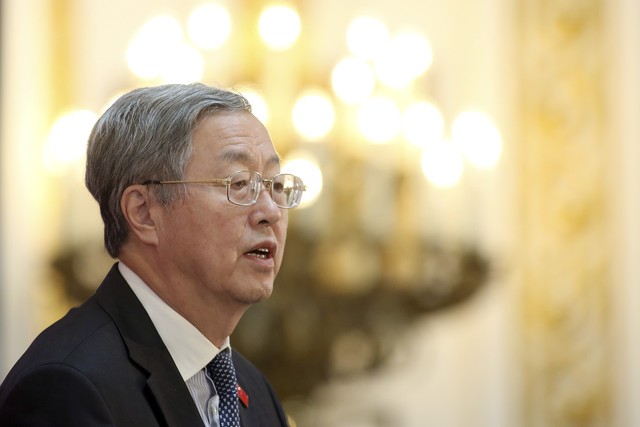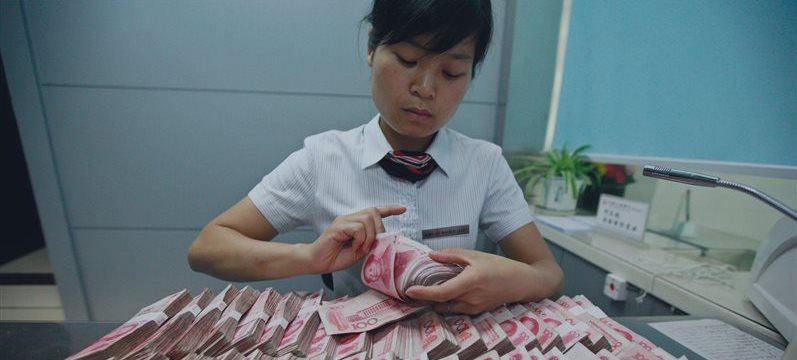China expanded banks’ freedom to set foreign-currency deposit rates in Shanghai, a step toward easing interest-rate controls across the nation.
On the photo: PBOC Governor Zhou Xiaochuan
The People’s Bank of China said today it will remove the ceiling on foreign-currency deposit rates across the city effective tomorrow for what it described as small accounts. The trial will start with institutional accounts and individual accounts will be added later based on “market conditions,” it said in a statement.
The PBOC abolished limits on foreign-currency interest rates on March 1 for deposits of less than $3 million inside Shanghai’s free-trade zone as part of plans to give markets a greater role in setting prices. The central bank, which removed the floor on most lending rates in July 2013, will liberalize state-set deposit rates within one to two years, Governor Zhou Xiaochuan said in March.
China expanded banks’ freedom to set foreign-currency deposit rates in Shanghai, a step toward easing interest-rate controls across the nation.

On the photo: PBOC Governor Zhou Xiaochuan
The People’s Bank of China said today it will remove the ceiling on foreign-currency deposit rates across the city effective tomorrow for what it described as small accounts. The trial will start with institutional accounts and individual accounts will be added later based on “market conditions,” it said in a statement.
The PBOC abolished limits on foreign-currency interest rates on March 1 for deposits of less than $3 million inside Shanghai’s free-trade zone as part of plans to give markets a greater role in setting prices. The central bank, which removed the floor on most lending rates in July 2013, will liberalize state-set deposit rates within one to two years, Governor Zhou Xiaochuan said in March.
“This is a small step in deposit-rate liberalization because forex deposits are a tiny fraction of the total,” said Dariusz Kowalczyk, senior economist at Credit Agricole SA in Hong Kong. “However, the removal of forex deposit caps does represent a step towards liberalization of interest rates and will increase hopes for raising the cap on yuan deposits in coming months. This in turn would lead to higher rates throughout the economy.”
Banks StruggleThe PBOC set a ceiling of 3 percent on one-year U.S. dollar deposit rates in May 2005, according to its website. Banks are currently offering well below that level, with Industrial & Commercial Bank of China Ltd., the nation’s largest lender, paying 0.8 percent and China Merchants Bank Co. paying 0.7 percent, according to their websites.
Interest-rate deregulation will add to pressure on China’s biggest banks, whose shares are trading near record-low valuations as they struggle with increasing non-performing loans and weaker earnings growth. Banks’ net interest margin, a key measure of lending profitability, fell to 2.58 percent as of March from 2.68 percent in December, according to the China Banking Regulatory Commission.
The central bank didn’t define the size of small accounts in today’s statement. The PBOC will take measures if it sees significant flows in deposits or large movements in interest rates at certain banks, until temporarily suspending the service, Zhang Xin, head of the PBOC’s Shanghai branch, said at a press conference in the city today.
‘Spill-Over Effect’
China had $565.8 billion of foreign-currency deposits as of
May, equivalent to about 3 percent of the 109.8 trillion yuan
($17.6 trillion) in local-currency savings, according to central
bank data.
Foreign-currency deposits in Shanghai account for one-seventh of the national total, or $76.7 billion at the end of May, of which 26.4 percent are deposited in small accounts, according to Zhang.
Local banks have set up a committee to regulate activity and prevent significant flows in deposits or large interest-rate changes, Zhang said. Existing regulations place few restrictions on customers opening accounts in different places, so money transfers aimed at taking advantage of rate differentials within a bank need to be properly controlled, Zhang said.
“There could be broad spillover effects,” he said. “We hope the market will be basically stable: no abnormal or large changes in interest rates, or large flows of deposits between banks or across regions within the same bank.”
Complete Liberalization
The State Council, or cabinet, said after a meeting last
month that the government will cut funding costs and maintain
reasonable growth in credit as economists forecast the weakest
expansion in 24 years. The banking regulator on June 6 vowed to
expand loans to small businesses, infrastructure projects and
first-home buyers, and said it may ease the ratio of loans to
deposits by including some stable sources of deposits in the
calculation.
“We are just a few steps away from a complete interest-rate liberalization,” said Tang Yayun, a Shanghai-based analyst at Northeast Securities Co. “But the process could be delayed as the government battles against a slowing economy and rising borrowing costs. Naturally the deregulation would lead to higher deposit rates and eventually higher borrowing costs for companies.”



